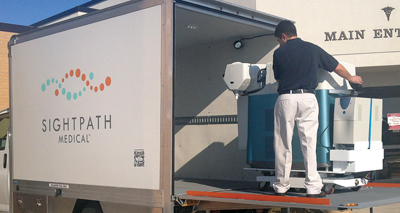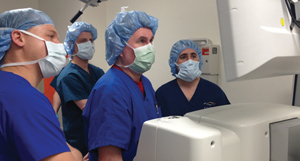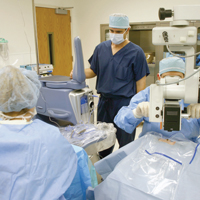Why Some Go Mobile
Mobile companies offer devices for many ophthalmic procedures, including phacoemulsification, selective laser trabeculoplasty, YAGs and now, femtosecond cataract surgery.
Warwick, R.I., ophthalmologist Paul Koch was interested in femtosecond cataract, but wasn’t sure buying a laser was the right move for him. “We purchased an excimer laser for LASIK in 1995 when it was first approved,” he says. “Over the years, we’ve had seven excimer lasers. They’re very expensive, the maintenance fees are high, and they get upgraded frequently. Now the early generations of femtosecond lasers for cataract surgery have come out and we can picture them being upgraded every six to 12 months. By the time we purchase one and get used to it there’ll be a new model coming out, but we’ll be stuck with a half-million dollar white elephant on which we still have to pay our monthly fee and maintenance. So we decided early on we weren’t going to be one of the early adopters of this technology.” Dr. Koch decided to use the MoFe mobile LenSx femtosecond laser for cataract surgery, provided by Sightpath Medical. “We don’t have the overhead and have an agreement that works for both us and them,” he says.
|
Another mobile company, ForTec Medical, recently entered an agreement with AMO to provide a mobile Catalys femtosecond option to practices. Patrick Filipovitz, vice president of sales and marketing for ForTec, says that in addition to being “cash-flow positive” from the first case—since the practice didn’t have to buy the laser—and being protected from equipment obsolescence, practices also appreciate the technician that stays with the laser during its use. “The technician that accompanies the laser and helps with the cases spares the practice the need to hire a new employee or provide additional training for a current one.”
Mrs. Deters notes facility managers appreciate her company’s ability to take away their “back-office” headaches. “Our staff takes care of ordering, financing and managing inventory; handling equipment maintenance and repairs; providing the required number of micro-instrument sets; and ensuring that the IOLs are there for a particular surgery day,” she says. “For IOLs, this means making sure that the surgeons have the appropriate diopter lenses in the correct quantities.”
Mobile Services
If a practice is interested in a mobile service, it has several companies to choose from. Here’s a look at each one and how its service works:
• ForTec Medical. In addition to the recent addition of the AMO Catalys, ForTec also makes available the Ziemer LDV femtosecond LASIK laser, the Visx excimer, and various YAG, ophthalmic diode and photodynamic therapy lasers. ForTec, headquartered in Streetsboro, Ohio, serves most of the United States except for several areas in the north.
ForTec’s Mr. Filipovitz, explains how the company’s new femtosecond laser cataract service works. “The laser is set up in the doctor’s surgical suite, either in the OR or in a different room nearby,” he says. “The set up is typically done on the afternoon of the day before the cataract cases. The ForTec technician will set up and calibrate the laser, and will be there to run the equipment during the time the surgeon does the procedures, providing general technical assistance and acting as an active member of the physician’s staff.”
If surgeons are interested in ForTec’s Catalys service, the company offers the chance to be certified on the laser without necessarily making any commitment. “We offer surgeons the opportunity to be certified through a didactic course given by an AMO clinical applications specialist,” Mr. Filipovitz explains. “Then, the surgeon has to do at least 10 eyes with the Catalys under the supervision of the applications specialist. We will also provide some marketing support, consisting of brochures, an animation that explains the procedure and a tablet computer that will explain the procedure to patients. After the first 10 eyes and after the surgeon is certified, we’ll ask for a one-year commitment with a minimum of 60 eyes to be treated in that timeframe.” The company offers a 50-percent discount on the Catalys’ liquid optics interface, a disposable instrument that enables the system to operate on a patient, for the 10 eyes operated on during this certification period.
If a practice enters into an agreement with ForTec Medical, for a single surgeon the company asks for a minimum of 10 eyes per visit. If it’s a multi-surgeon site that can accommodate multiple surgeons in a day or over two consecutive days, ForTec will reduce that minimum to seven eyes per surgeon.
In terms of pricing, it’s a per-eye price. “A typical per-eye price for a single surgeon doing a 10-eye minimum is $850 per eye,” explains Mr. Filipovitz. “That covers the liquid optics interface and a small fee for the equipment rental.”
For information, call 1 (800) 963-7101 or visit fortecmedical.com.
• Sightpath Medical. Sightpath, based in Minneapolis, serves every state except Hawaii, providing both mobile and fixed-site applications.
|
On the refractive side, Sightpath is primarily mobile, though it also has some fixed sites. The company offers both Visx and WaveLight excimer lasers, and the IntraLase for LASIK. The company is also beginning to offer marketing services to help practices deliver their key messages to patients.
The latest addition to Sightpath’s services is the MoFe mobile femtosecond for cataract surgery. With MoFe, a practice enters into an agreement with Sightpath and must have at least six femto cataract cases scheduled per visit. When a surgery day is scheduled, Sightpath’s engineer will bring the laser to the practice the night before to calibrate it. “As we moved into MoFe, we found that for many of our clients this was their first exposure to this type of device and the possibility for a breakdown,” Mr. Gaslin says. “So having that engineer there to get it going is important. Short of a major engine failure, our engineer can keep the device running.”
The pricing of MoFe changes based on the practice’s volume. “The more cases we do, the more efficient we get,” says Mr. Gaslin. “So our pricing models are built to share that efficiency benefit with the practice as we do more cases. We’ve done 13,000 MoFe procedures now, and our average per-procedure price across those procedures is around $775. And, as you do more cases, it’ll get down to where it’s below $700.” In terms of scheduling, Mr. Gaslin says that practices start at once a month and quickly want to go to every other week. “Practices agree to a schedule about a year in advance,” he says. “But within that there is flexibility if they need more access or need to cancel—as long as they give notice at least five days ahead of time.”
For information, call 1 (888) 975-5828 or visit laservision.com.
• Surgical Direct. Surgical Direct provides practices with phaco equipment and other cataract surgery materials, such as intraocular lenses and disposables. It also offers lasers for glaucoma procedures and YAG capsulotomies. The company’s based in St. Louis, but can service the rest of the country. States it currently serves include Missouri, Illinois, Kansas, Louisiana and California.
Ted Barden, vice president of sales for Surgical Direct, says the technicians that accompany the equipment are a benefit to practices. “Some facilities may only do cataracts one time a month and then, 29 days later, all the staff in the OR has forgotten how to do cataracts,” he says. “Our techs are in the room running the equipment and the microscopes. If someone’s having trouble loading a lens, the tech can help him.”
In terms of minimum cases, Mr. Barden says it varies based on the distance, the procedure they’ll be doing and the volume. “There’s no cookie-cutter minimum,” he says. “We look at each facility individually and provide a solution for whatever will best fit their needs. Ninety percent of what we do involves signing an agreement with them, because sometimes, depending on their location, we may have to hire additional technicians and acquire additional equipment. Typically, it will be a two to three-year agreement, but there are situations where we’ve structured it differently.
“We also have an on-call service,” Mr. Barden adds. “This is based on the fact that a lot of the surgical reps have their equipment in a facility. If their equipment goes down and they can’t get a technician to fix it, but the surgeon has cases the next day, the facility will call us and we’ll bring in the microscope and phaco machine.”
For information, call (314) 997-4455 or visit surgicaldirectinc.com.
• Vantage Outsourcing. Vantage, based in Effingham, Ill., provides all major brands of phaco equipment, surgical microscopes from Leica and Zeiss; and YAG and SLT lasers. It also offers a fixed-site femtosecond laser cataract service through a partnership or lease arrangement. The company serves the continental United States.
|
Facilities enter into a contract with Vantage, the length of which varies but is a minimum of a year. The company then works out a visit schedule with the facility and physician practice. “Typically these times are blocked months in advanced, but we have some practices that may notify us one week prior,” Mrs. Deters says. “On a given day, Vantage may be providing services for 25 or more accounts, with each doing from five to 40 cases or more.
“Another scenario may involve a metropolitan physician who satellites to five different locations, all of which contract with Vantage,” Mrs. Deters adds. The surgeons operate at these centers once, maybe twice a month. It’s tough for these rural areas to recruit permanent surgeons, so we bring the surgeons to them and the local optometrists provide the postop follow-up. Patients love that they don’t have to drive 30 miles for surgery.”
For information, call 1 (877) 564-3937 or visit vantageoutsourcing.com.
Issues and Concerns
With femtosecond cataract surgery being the hot new technology, mobile providers are deciding the best way to implement it and avoid any potential problems.
Some think that the time required to calibrate the femtosecond after moving it makes it a planning problem for practices, and that a three or four hour setup time can cause logistical headaches.
ForTec Medical says any problems with the calibration time may be minimized in the future. “Right now, the install times are as much as three hours,” says ForTec’s Mr. Filipovitz. “With some optimization in training we can get it installed slightly faster than that. We have a protocol from AMO coming that should reduce that install time to below an hour. So, if a practice is worried about the inconvenience of having someone stay until 6 or 7 o’clock for us to set up the laser, yes that is a downside to mobile currently. But, in the future we’re hoping that we can do it the morning of the cases and be less disruptive to the practice’s schedule.”
Another question surgeons raise with mobile companies in their discussions is how well surgical equipment can handle riding in a van. Mr. Filipovitz says they take these questions to heart. “There is a custom air-ride suspension in the new vans that we use to transport the Catalys,” says Mr. Filipovitz. “There’s also a device that slides underneath the laser to support it that was designed to withstand a shock 30 times more than the most aggressive pothole you could find in the United States. We’ve also been through three different shake tests, one with OptiMedica and two with the AMO staff, to make sure there would be no risk of the system underperforming due to some transport shock. We’ve had no issues caused by mobility since we started performing cataract cases with it 120 days ago.” REVIEW








